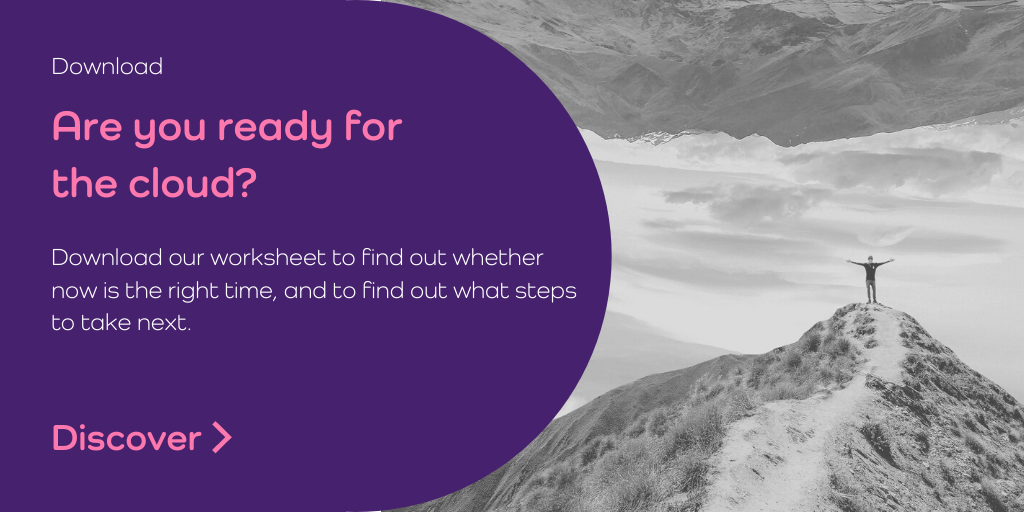The cloud provides businesses with the opportunity to improve operations, agility, security, cost efficiency and flexibility. It is important, however, to remember that unless you can successfully migrate to the cloud and then leverage the benefits, the opportunity may remain untapped.
A cloud migration that is performed inefficiently or incorrectly won’t net the return on interest that organisations are looking for. Ultimately, an unsuccessful cloud migration attempt can see businesses forced to shift back to a rigid on-premises solution.
It’s crucial, then, that organisations engage with experts to manage their cloud migration, as well as help them get the most out of digital transformation. Getting access to cloud migration experts can be a challenge for smaller businesses without an IT department or healthy budget, but fear not – a managed service provider makes expert support accessible to everyone for a reasonable cost.
Is your organisation ready for the cloud? Download our cloud readiness worksheet to find out >
Why cloud migrations fail
A common reason why cloud migration can fail is because the project manager has failed to obtain stakeholder buy-in, whether internal or external. Cloud technology has been making headlines for a few years now but is still a new concept across many industries and many businesses fear that change will disrupt their operations. It’s a project in itself to get all employees supporting change and if key stakeholders oppose or don’t see the value in a migration, then the project can’t move forward successfully.
Pressure to migrate quickly can also lead to failure. Sometimes key stakeholders are eager to reap the benefits of migration as soon as possible. Pressure on the project manager or migration manager can lead to a rushed or poorly thought-out migration. Without research and planning, businesses may lack clarity on what they should and shouldn’t migrate and end up migrating inappropriate applications. This can quickly lead the migration adrift and increase costs.
Cost analysis is also a key failure trigger. There can be multiple different costs factors associated with a cloud migration that aren’t always realised by businesses. Cloud providers draw customers in with low up-front costs and a seemingly affordable monthly fee. These prices, however, don’t include hidden costs such as data transfer allowances, fees, training, and support.
This is exacerbated further when a company misunderstands the performance requirements of applications. Certain workloads have specific technical requirements that make them poorly suited to the cloud. In a bid to solve performance issues, the first point of call is commonly to upgrade the plan, which may heavily impact ROI. This can be a particular problem for non-profits, who experience a high level of budgetary scrutiny and limited capital. The additional challenge of protecting sensitive information with often no IT staff can make it very difficult to succeed without support – the challenges mentioned above can easily be addressed with a managed service provider, who will be able to ensure cost alignment.
Cloud migration can also present business challenges surrounding security. If a business undergoes migration without the proper governance and control, there are security risks. A user might unknowingly modify security controls in a way that doesn’t follow your security policies.
In the education sector, we’ve seen this cause particular damage. The amount of student information and research stored electronically means the stakes are high and the pickings rich for attackers. The fact that educational institutions must also worry about increased bandwidth, pre-existing licensing deals, and cultural shifts only complicates matters further.
How to migrate successfully
So, how do you avoid these pitfalls? Just being aware of the reasons why migrations fail is a good start. Many of these common issues are linked; over-eager stakeholders lead to rushed deployments, and those, in turn, can lead to weaknesses in security or improper assessment of applications.
In nearly all cases, the keys to success are the same: communicate with clarity, take things at a steady pace, and obtain expert support. Usually, a phased approach to migration makes the most sense. Carefully planning which applications to include in each stage and their potential complications will allow you to meet deadlines and set clear expectations.
Working with a reputable MSP to support or even manage your migration can be invaluable. A good managed service provider will lend weight during stakeholder discussions while providing accurate assessments and an achievable migration timeline.
Managed cloud migration may not 100% guarantee success, but it will greatly reduce the risk while helping you to achieve your desired goals. Get in touch with us today to learn how we can help you remain competitive in a secure, cost-effective way.







